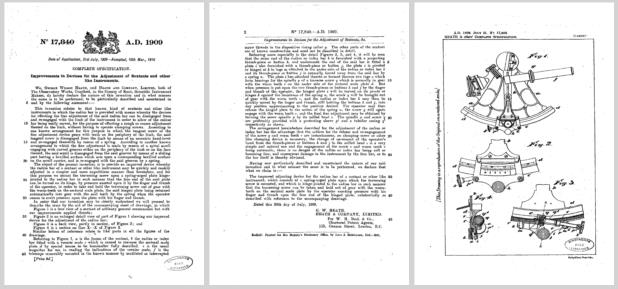
NavList:
A Community Devoted to the Preservation and Practice of Celestial Navigation and Other Methods of Traditional Wayfinding
Re: What is a "Class A" sextant?
From: Stan K
Date: 2014 Jan 19, 22:22 -0500
From: Stan K
Date: 2014 Jan 19, 22:22 -0500
Brad,
There may be something to "Class A means total errors less than 30 seconds and Class B less than 3 minutes".
My Heath is a Class A, with a maximum error of 0.4', less that 30" or 0.5'.
I was able to open that site, but it was just a Journal of Navigation buy a copy. No information at all.
Stan
There may be something to "Class A means total errors less than 30 seconds and Class B less than 3 minutes".
My Heath is a Class A, with a maximum error of 0.4', less that 30" or 0.5'.
I was able to open that site, but it was just a Journal of Navigation buy a copy. No information at all.
Stan
-----Original Message-----
From: Brad Morris <bradley.r.morris@gmail.com>
To: slk1000 <slk1000@aol.com>
Sent: Sun, Jan 19, 2014 9:07 pm
Subject: [NavList] What is a "Class A" sextant?
From: Brad Morris <bradley.r.morris@gmail.com>
To: slk1000 <slk1000@aol.com>
Sent: Sun, Jan 19, 2014 9:07 pm
Subject: [NavList] What is a "Class A" sextant?
I've been asked this question. And I've asked it myself. "What is a Class A sextant? I've never found a satisfactory answer.
Here's a tidbit from random internet searching:
"This won't be too much use but perhaps it will stimulate some discussion. if memory serves me correctly (from the 1980s) sextants were designated by class. I think it was Class A, B or C. The major ships had one high end sextant (Class A?) which was very modern with good optics, etc. The Navigator kept that one locked away and a good navigator wouldn't let anyone else touch it. The other sextants, which were kept in the chart table for general use by watch keepers, were a lower class. It seems to me that they were all British manufacture but by various manufacturers and with some minor differences in design and function. They all looked to date back to at least WW II and perhaps earlier."
Here's another one:
"I'm not sure what other classification systems are in use around the world, but British or former-British colonies would likely use the Brit classifications, which I believe were set by the Royal Observatory - Class A means total errors less than 30 seconds and Class B less than 3 minutes"
"I'm not sure what other classification systems are in use around the world, but British or former-British colonies would likely use the Brit classifications, which I believe were set by the Royal Observatory - Class A means total errors less than 30 seconds and Class B less than 3 minutes"
Here's a reference I could not open , maybe someone else can open it.
"A Critical Table for Sextant Corrections
journals.cambridge.org/abstract_S03734...
by JPG Worlledge - 1948
Jan 18, 2010 - The N.P.L. Class A Test, issued for instruments reading directly to 10"
"
"A Critical Table for Sextant Corrections
journals.cambridge.org/abstract_S03734...
by JPG Worlledge - 1948
Jan 18, 2010 - The N.P.L. Class A Test, issued for instruments reading directly to 10"
"
I found a reference that states Kew Observatory charged 5 s[hillings] for a class A certificate, but did not mention the tolerance.
Brad
On Jan 19, 2014 8:27 PM, "Stan K" <slk1000---.com> wrote:
So that's how it works!
-----Original Message-----
From: Brad Morris <bradley.r.morris---.com>
To: slk1000 <slk1000---.com>
Sent: Sun, Jan 19, 2014 1:07 pm
Subject: [NavList] Re: Beating a Dead Horse (aka Worley's Sextant)
DonThank you!Is there any chance at the "Patent Greatest Angle Clamp" paperwork. Undoubtedly a UK patent but there is no associated patent number with this one. The patentees will be the same as 17840, if that's any help.BradOn Jan 19, 2014 11:42 AM, "Don Seltzer" <timoneer---.com> wrote:
Stan wrote: In an earlier message I said that Bill's site said the "endless tangent screw" patent was in 1909. I now also note from the site that I might have misinterpreted that. Heath may have applied for the patent in 1909 but did not receive it until March 1910. It was patent no. 17840. Does your sextant actually say "Patent 17840" on it? Mine simply says "Patent" on the tag on the front of the clamp mechanism and on the back of it.
Attached is Heath's patent.Don Seltzer
----------------------------------------------------------------
NavList message boards and member settings: www.fer3.com/NavList
Members may optionally receive posts by email.
To cancel email delivery, send a message to NoMail[at]fer3.com
----------------------------------------------------------------
Attached File:
(Heath-GB190917840A.pdf: Open and save or View online)







